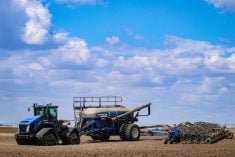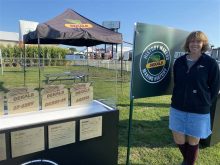After Bayer’s “dream team” panel of canola breeders and developers met at Ag in Motion to discuss their work on “the highest-yielding DeKalb canola hybrid yet,” an audience member posed the inevitable question: What’s next?
The team, which included canola breeder Dale Burns, plant health product developer Xuehua Zhang, market developers Tim Darragh and Tim Gardner and canola product developer Liz Simpson, spoke Wednesday. They described some of the new pathways they can now use to get there.
Read Also

Brazil to reap record soy crop in 2025/2026, increase exports
Brazil’s Conab said the country will reap a record soybean crop of 177.6 million tons in the 2025/2026 harvest year, according to data released on Thursday.
“One thing that is working in our favour in this country is that the Canadian government did announce that they would look at gene-edited crops as not requiring any extra regulatory approval steps,” Burns said, referring to Ottawa’s decision on guidance for plant breeding in May last year.
“Certainly that opened the door to groups like ourselves to dive into that gene editing, identifying traits that could bring enhanced protection, could bring enhanced quality, some of those types of things (whereas previously) we were operating a little bit in the dark as far as whether that was an option or not for us for several years.”
Noting the discussions about the value of autosteer technology for farmers 10-15 years ago, Simpson now looks in the same way at artificial intelligence, and A.I.-supported predictive modelling of conditions such as drought, heavy rain and high heat, “so we don’t necessarily have to ever push through failure in a field.”
While such modelling may seem “a little funky and ‘out there’ today, I think that’s going to be very commonplace 10-15 years from now (and the industry will) be very comfortable putting things into simulations and understanding what that’s going to look like before we ever put it in a field,” Simpson said. “We’re going to have a digital picture of how this is going to perform in Western Canada.”
Such new tools will also add new efficiencies to the breeding and selection process. Breeding for disease resistance takes longer than breeding for yield, Zhang said, as new pathotypes and pathogen populations emerge over the years.
Bringing forward source material for resistance is also a time-consuming process, Burns said. “As we scour the world for sources of resistance to different diseases, sometimes they’re not very good — they’re not canola. When you start with something that’s a wild relative of canola, that adds a lot of years to being able to bring it into a high-performing hybrid in the marketplace… quite often you’re starting with material that’s really not adapted to being grown here.”
Provincial disease surveys, Burns said, are a critical tool in monitoring for outbreaks and ensuring breeders are aware not only of what the disease pressures are. Zhang, he noted, does “an amazing job of (identifying) which races of each disease are most present, and where we need to focus those breeding efforts” while also working to anticipate the upcoming disease races on which the trend lines are just beginning to rise.
New tools and innovations, Zhang added, have already allowed developers to reduce that disease resistance work by one to two years — but they need to ensure there’s no “yield drag” or other issues with a disease-resistant trait before bringing it into the company’s breeding pipeline.
From the point where the company starts its initial work developing new parents of hybrids, up until when a new hybrid is deployed into the market, is around seven years, Burns said — two years in early development and five in testing to confirm performance, “checking for that stability across environments, picking the cream of the crop that goes on to the next year of testing.”
These new tools won’t shorten that total cycle, he said, but the efficiency with which companies can select for higher yield will be greater.
“We use a lot of genetic predictions and they’re really good — in some ways more effective than doing some of the first years of testing (but) we still want to have potential new products experience a lot of environments and look for things that maybe the models didn’t predict very well. There’s a lot of predicting things, but also you still have to prove it and you still have to put it out there and make sure that it’s what the predictions were saying.”
The best of the best, he said, are still proved out on the field — especially at farm scale. Small plots are good but not great at predicting actual yield; the final decisions will still rely on farm-scale, grower-performed trials.
Farmer priorities
From the grower’s point of view, Darragh said, “if you ask a farmer what he wanted in his canola hybrids, he’d say ‘Everything’” — but yield tops the priority list.
“We need to have performance; that’s how they pay the bills, is with money, so they want to make sure they’ve got products that are going to yield well and give them good profit.”
Gardner agreed yield remains top priority — and growers also want to know how well a variety can hold that yield “when things go south.”
Over the past four decades, Burns said, seed developers “probably haven’t raised the yield ceiling nearly as much as we’ve raised the yield floor,” adding that apart from genetic advancements, increased moisture conservation through zero-till has been a big factor in ensuring enough moisture remains available to canola at seeding.
Beyond yield, rowers’ top-of-mind priorities will vary as they face different challenges region by region, Darragh said.
“When you think of northern Alberta, clubroot is kind of that priority, so to have a good disease tolerance and access to novel sources of clubroot resistance, that’s a key thing,” whereas in Manitoba, straight-cut harvestability is a major consideration.
Harvest management, Gardner agreed, “is such a key thing all the time…I’ve been saying this a lot this year, where aside from traits…nobody is long on time, so anything that slows you down or costs you time is very important — and the other thing is, nobody likes bad surprises. People like good surprises, but nobody likes bad surprises.”
Past that, Darragh said, weed management is also a priority across the board, particularly herbicide-resistant species of wild oats and kochia.
DeKalb’s TruFlex Liberty Link gives growers an option to manage multiple spectrums of resistant weeds and a variety such as the new DK401TL promoted at the AIM show, is “bringing all those things in one hybrid.”















